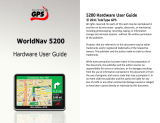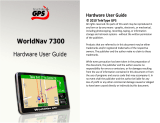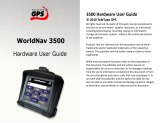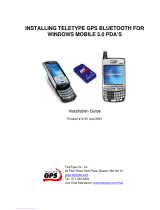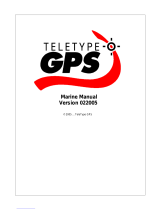Page is loading ...

All rights reserved. No parts of this work may be reproduced in any form or by any means - graphic, electronic, or
mechanical, including photocopying, recording, taping, or information storage and retrieval systems - without the
written permission of the publisher.
Products that are referred to in this document may be either trademarks and/or registered trademarks of the
respective owners. The publisher and the author make no claim to these trademarks.
While every precaution has been taken in the preparation of this document, the publisher and the author assume no
responsibility for errors or omissions, or for damages resulting from the use of information contained in this document
or from the use of programs and source code that may accompany it. In no event shall the publisher and the author be
liable for any loss of profit or any other commercial damage caused or alleged to have been caused directly or
indirectly by this document.
Printed: June 2004 in (Boston, MA USA)
TeleType GPS Mini-Bluetooth GPS Receiver
© 2004 TeleType GPS

Table of Contents
Pa
rt I
Teletype GPS Bluetooth GPS 2
Pa
rt II
Overview 2
Pa
rt III
Features 3
Pa
rt I
VTechnical Specification 3
...................................................................................................................................
31 Basic Specification
...................................................................................................................................
32 Acquistion Time (Averaged)
...................................................................................................................................
43 Receiver Accuracy
...................................................................................................................................
44 Limitations
...................................................................................................................................
45 Power Supply
...................................................................................................................................
46 Output & Interface
...................................................................................................................................
57 Physical Specification
...................................................................................................................................
58 Other Functions
Pa
rt
VGPS Signal Reception 5
Pa
rt
V
I
Hardware Description 6
...................................................................................................................................
61 Device Description
...................................................................................................................................
72 LED Status
...................................................................................................................................
73 Power Switch
Pa
rt
V
II
Understanding Your Receiver 7
...................................................................................................................................
71 Charging Your Battery
...................................................................................................................................
82 Turning The Power On
...................................................................................................................................
83 Receiver Status Chart
Pa
rt
V
III
Connection 9
Pa
rt I
XFrequently Asked Questions 11
Pa
rt
XCare and Maintenance 12
Index 0
TeleType GPS Mini-Bluetooth GPS ReceiverI
©
2004
T
e
l
e
T
y
pe
G
PS

T
ele
t
y
p
e
G
PS
B
l
u
e
tooth G
PS
2
© 2004 TeleType GPS
1
Teletype GPS Bluetooth GPS
Congratulations on your purchase of the TeleType GPS Mini-Bluetooth GPS receiver with built-in
LiON rechargeable batteries. Before you begin, make sure that your package includes the
following items. If any of these items are missing, please contact
.
·
TeleType GPS Mini-Bluetooth GPS receiver
·
Car Power Adapter
·
A/C Power Adapter
2
Overview
The
TeleType GPS Mini-Bluetooth GPS receiver with built-in LiON rechargeable batteries
(
Product #2951
) pictured above is a total solution GPS receiver with Bluetooth, a UART interface
and a built-in rechargeable battery for high sensitivity to tracking signal.
Its design is based on
the SiRF Star IIe/LP low power architecture and it is a dual-function GPS receiver. The receiver
transmits satellite information through a Pocket PC or a notebook with Bluetooth interfaces. Also,
when transmitting information through a data cable, this G-Mouse GPS receiver is able to deliver
satellite signals to the device without the Bluetooth interface.
This positioning device is useful for many operations such as car navigation, mapping, surveying,
security, agriculture and so on; only a clear view of the sky and a power supply are necessary for
the unit to function. This receiver is able to contact other devices through the Bluetooth interface
or by USB. It also has a built-in rechargeable battery to save satellite information such as the
status of the satellite signal, the most recent location, and the date and time of its last use.
With its low power consumption, the Bluetooth GPS Receiver tracks up to 12 satellites at a time,
re-acquires satellite signals in 100 ms and updates position data every second. Trickle-Power
allows the unit to operate only a fraction of the time and Push-to-Fix permits the user to have a
quick position fix, even though the receiver usually stays off.

TeleType GPS Mini-Bluetooth GPS Receiver3
©
2004
T
e
l
e
T
y
pe
G
PS
3
Features
The TeleType GPS Mini-Bluetooth GPS receiver with built-in LiON rechargeable batteries has
many uses and features. It is well suited for system integration and for users who use Pocket
PCs and laptops with a Bluetooth interface.
·
Built-in SiRF Star IIe/LP low power consumption chip set
·
12 parallel satellite tracking channels, for fast acquisition and reacquisition
·
High-speed signal acquisition using 1,920 time/frequency search channels
·
Built-in WAAS/EGNOS Demodulator without any required additional hardware
·
Fully compatible with Bluetooth Serial Port Profile (SPP)
·
Built-in rechargeable Lithium-ion battery without external power supply
·
Two modes to suit the user's preference (Power Saving mode and Continue mode)
·
Allows a terminal contact to another system without a Bluetooth device
·
Built-in rechargeable battery for memory and RTC backup and for quick Time To First Fix
(TTFF)
·
Support NMEA0183 v2.2 data protocol and SiRF binary code
·
4-color LED status indicator
·
Active antenna connector for getting better satellite reception
·
FLASH-based program memory
·
Small, sleek, and lightweight design made to fit in your hand
·
Enhanced algorithms such as SnapLock and SnapStart provide superior navigation and
performance in seasonal, urban and rural environments
·
Ideally applied for car navigation, marine navigation, fleet management, AVL, personal
navigation, tracking and mapping.
4
Technical Specification
4.1
Basic Specification
Basic Specification:
·
Chip set: SiRF Star IIe/LP
·
Channels: 12 parallel satellite-tracking channels
·
Frequency: 1575.42 MHz
·
Receiver: L1, C/A code
4.2
Acquistion Time (Averaged)
Acquisition Time (Averaged):
·
Reacquisition: 0.1 seconds
·
Snap start: < 3 seconds (at < 25 minutes off period)
·
Cold start: < 45 seconds
·
Warm start: < 38 seconds
·
Hot start: < 8 seconds
·
Update rate: 1 second continuously

T
ec
hn
ical
S
p
eci
f
ica
t
i
on
4
© 2004 TeleType GPS
4.3
Receiver Accuracy
Receiver Accuracy:
·
Normal: 5 - 25 meters (16 - 82 feet) CEP without SA
·
Enable EGNOS or WAAS:
Position:
< 2.2 meters (7.2 feet), horizontal 95% of time
< 5 meters (16 feet), vertical 95% of time
·
Velocity: within 0.1 meters / second
·
Time: 1 microsecond synchronized GPS time
4.4
Limitations
Limitations:
·
Altitude: < 18,000 meters (60,000 feet)
·
Velocity: < 515 meters (1,690 feet) / second (700 Knots)
·
Acceleration: 4 G
·
Jerk: 20 meters (66 feet) / second
4.5
Power Supply
Power Supply:
·
External Voltage: 5 VDC +/- 10%
·
Batteries:
·
Main Power:
Built-in rechargeable Lithium-ion battery for system power
·
Backup Power: Rechargeable Lithium-ion battery for memory & RTC backup
·
Working voltage:
·
Normal Mode: 80-90 mA
·
Power Saving Mode: 30 mA
·
Working period (assuming full battery):
·
Continue Mode: 9 hours
·
Power Saving Mode: 16 hours
4.6
Output & Interface
Output and Interface:
Output:
1) Output protocol
·
Baud Rate: 9600 bps
·
Data bit: 8
·
Parity: No
·
Stop bit: 1
2) Format: NMEA0183 V2.2
(Optional GLL, VTG or SiRF binary format)
·
GPGGA (1 time per second)
·
GPGSA (1 time per second)
·
GPGSV (1 time per 5 seconds)

TeleType GPS Mini-Bluetooth GPS Receiver5
©
2004
T
e
l
e
T
y
pe
G
PS
·
GPRMC (1 time per second)
3) Datum: WGS84
Input/ Output Interface:
·
Compatible Bluetooth Serial Port Profile (SPP): v1.1 and class 2 (maximum 10
meter range)
External Antenna Interface:
·
3.0V input MCX-type active antenna connector
4.7
Physical Specification
Physical Specification:
·
Size: 72 mm x 55 mm x 21 mm
·
Weight: < 75 grams (2.7 ounces)
·
Operating Temperature: -10
°
C to + 60
°
C (14
°
F to +140
°
F)
·
Storage Temperature: -20
°
C to + 85
°
C (-4
°
F to +185
°
F)
·
Operating humidity: 5% to 95%; No condensing
4.8
Other Functions
Other Functions:
·
Bluetooth frequency: 2.4 ~ 2.48 GHz
·
Bluetooth Input Sensitivity: -80 dbm
·
Low sensitivity of receiving satellite signal: -175 dBW
·
LED Functions: Indicate Bluetooth status, GPS status, Battery Status and Battery
charging status
5
GPS Signal Reception
The TeleType GPS Bluetooth GPS receiver offers high position accuracy and fast Time-To-First-Fix
(TTFF). These rely on environmental factors, such as where the receiver is located and the initial state
of the receiver. While attempting a position fix, the receiver needs to be locked-on to at least four
satellites. The TeleType GPS Bluetooth GPS Receiver then uses the signals received from the
satellites, along with data from the receiver's digital memory about the last position fix, in order to
compute the current location of the device.
Environmental factors that influence position accuracy and initial GPS position fix are:
·
Tall buildings
·
Narrow street and passageway
·
Protection film on glass
·
Heavy foliage
·
Large cliffs
·
Other obstructions where the satellite signals may blocked

G
PS
S
i
gn
al
R
ece
pt
i
on
6
© 2004 TeleType GPS
·
Poor satellite geometry situations
The initial state of the receiver refers to the last status of the receiver in memory. This mainly
determines the length of time it will take for your GPS receiver to obtain a position fix. Your position
can be quickly fixed within 8 seconds from a "hot-start" state, and typically 45 seconds from a "cold-
start" state. It takes at least 3 to 5 minutes to obtain a position fix from a completely restart-state, for
example, flying at a distance over 300 miles from the initial origin.
The TeleType GPS Bluetooth GPS Receiver uses the satellite signals to calculate your exact location
by computing your distance from the satellites. The position data within the receiver is then converted
into latitude and longitude coordinates, which are usually provided in the geodetic datum on which the
GPS is based (WGS84). Using the wrong datum can result in position offsets for many miles.
In addition to incorrect datum, there are a number of positioning errors that can occur which affect the
accuracy of your TeleType GPS Bluetooth GPS Receiver. The major errors including satellite orbiting
errors, poor satellite geometry, multi-path signals, atmospheric delay, and receiver clock timing.
6
Hardware Description
6.1
Device Description
Device Description:
*Your actual TeleType GPS Mini-Bluetooth GPS receiver may look different from the one pictured above, but the functions and
buttons are the same.

TeleType GPS Mini-Bluetooth GPS Receiver7
©
2004
T
e
l
e
T
y
pe
G
PS
6.2
LED Status
LED Status:
SYMBOL
COLOR
STATUS
DESCRIPTION
Bluetooth
Blue
Blinking
3 times / second: searching Bluetooth device
1 time / 3 seconds: standby mode
1 time / second: transferring data
Battery
Red
Green
None
Light On:
Light On:
Light Off:
Low Battery
Charging
Charged or not charging
Power
Orange
Light On:
Blinking:
Acquiring satellites
Position fixed
6.3
Power Switch
Power Switch:
I = On
0 = Off
7
Understanding Your Receiver
7.1
Charging Your Battery
Charging the Battery:
Take the power cable and connect it to the power socket. This will begin to charge the battery.
For the first use, please charge battery until it is full (the LED turns off).
The LED that represents the battery is the right-most battery icon (shown in the first picture).
If the LED is red, that means that the power is too low.
If the LED is green, that means that the power is charging.
If the LED is off, that means that the battery is either full or not charging.

Und
e
r
s
t
a
nd
i
ng You
r
R
ecei
v
e
r
8
© 2004 TeleType GPS
7.2
Turning The Power On
Turn The Power On:
The LED that represents the Bluetooth connection is the middle Bluetooth logo icon (shown in
second picture). The LED that represents the power is the left-most power icon (shown in the
third picture).
Switch the power of the TeleType GPS BlueTooth GPS receiver on.
Make sure that the receiver
is in clear view of the sky without any obstruction for better satellite acquiring.
Your receiver will
search for a connection to a Bluetooth device. While searching, the LED will blink once every
three seconds. If the Bluetooth receiver does not detect any devices, it will turn off in five
minutes.
When the receiver detects a device, it will see if data transfers from the receiver to the device
and the LED will blink every second. It will blink once every three seconds in the case that it is
no longer transferring data, or cannot transfer data and is trying to reconnect to the device. This
is described below in the status chart of the receiver.
The third LED (orange), the power indicator, will glow without blinking while the receiver fixes its
position. Once a position has been fixed, the orange LED will be blinking as well.
Note:
Some PDAs have to re-open Bluetooth manager for the Bluetooth device to reconnect.
7.3
Receiver Status Chart
Receiver Status Chart:

Conn
ec
t
i
on
10
© 2004 TeleType GPS
Begin by selecting
Start
->
Bluetooth Manager
.
Once in the program,
select
New
->
Connect!
Select
Explore A Bluetooth device
to
see what Bluetooth device you currently
have selected.
You will see the above screen, showing
that you do not have a Bluetooth device
selected. Click on
Next
.
You will see a device named TeleType.
Please click on this device. It will select
this device as your Bluetooth Browser.

TeleType GPS Mini-Bluetooth GPS Receiver11
©
2004
T
e
l
e
T
y
pe
G
PS
Verifying Your Connection:
Once you have completed the setup of your Bluetooth device, you may check to see if your TeleType
GPS software is attempting to fix your position. You can do this by opening your GPS software, and
selecting
Tools
->
GPS Status
. Go to the
Status
tab, and click on
Find GPS Port
. Shortly, you will
see the GPS code running as in the picture above. This signifies that your Bluetooth device is
functioning properly.
9
Frequently Asked Questions
Q: My Bluetooth host device is asking me for a passkey. What is it?
A: It is "6268".
Q: The TeleType software doesn't seem to be making any connections with my Bluetooth GPS
receiver. How do I make it work?
A: You will need to make sure your PDA is paired with the Bluetooth device. Follow the instructions in
the Connection section to make sure that your PDA is recognizing the Bluetooth GPS receiver
properly. If so, you will need to connect with the device by going to the Bluetooth Manager and double-
tapping on the TeleType icon.
Q:
My Bluetooth receiver seems to be connecting to satellites, but I am unable to establish a
connection between the receiver and my PDA. How can I make a connection?
A: Go to the Bluetooth Manager on your PDA. Locate the "TeleType: SPP Slave" icon and tap and
hold. A pop-up menu will appear, select Delete.
Next, locate the Reset button on your Bluetooth GPS receiver and press it. Then perform a soft reset
on your PDA.
Once your PDA has finished resetting itself, go back to the Bluetooth Manager screen and perform the

F
r
e
qu
e
nt
l
y
A
ske
d Qu
es
t
i
on
s12
© 2004 TeleType GPS
typical setup and connection procedures for your Bluetooth receiver (for help with connection, please
review the Connection section).
Finally, run the TeleType GPS software. Go to Tools > GPS Status > Status, select COM 8 as your
port, 4800bps, and tap Open Port. You should see symbols scrolling in the gray box below.
10 Care and Maintenance
Your TeleType Bluetooth GPS Receiver should be treated with care and properly maintained to ensure
the best performance. Keep in mind these helpful tips when using your receiver:
·
Keep this and all accessories out of small children's reach.
·
Keep your Bluetooth GPS receiver dry. Do not expose to rain, water, or high humidity environments.
Humidity, liquids, and precipitation contain minerals that will corrode its connectors, jacks, plugs, and
electronic circuit boards.
·
Use only the supplied and approved accessories. Unauthorized accessories, antenna, modifications
or attachments could damage the Bluetooth GPS receiver, and may violate regulations governing
radio devices.
·
Use a dry, clean soft cloth to clean the unit. Do not use harsh cleaning solvents, chemicals, or strong
detergents.
·
Do not drop, shake, or knock the Bluetooth GPS receiver. Rough handling can break the connector,
jack, and internal electronic circuit boards. This will cause non-recoverable damages to the product.
·
Do not store the Bluetooth GPS receiver in dusty, dirty areas. Its moving parts, like connector pins
and clips, can be damaged.
·
Do not store the Bluetooth GPS receiver in hot area. High temperatures can shorten the life of
electronic devices, and melt or drape certain plastics.
·
Do not expose your TeleType Bluetooth GPS Receiver to temperatures higher than 1
8
5°F (
85
°C).
Do not leave your Bluetooth GPS receiver in your car under direct sunlight while not in use.
·
Do not store the Bluetooth GPS receiver in cold temperatures. When the unit warms up to its
normal operational temperature, moisture can aggregate inside it, severely damaging the electronic
circuit boards inside.
·
Do not attempt to open the Bluetooth GPS receiver. Unauthorized handling may damage the unit,
and void your warranty.
·
Do not paint on the Bluetooth GPS receiver. Paint can clog the connector, jack, and prevent proper
normal operation of the unit.
/



